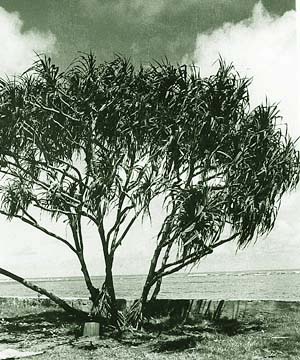


Ever Green

File photo
Hala grows well everywhere in Hawaii, but because the tree is
salt-resistant, it is especially well suited to areas near the ocean
BACK before the local tour guides were more carefully trained, they used to point out pineapple trees to their gullible passengers. There must be photo albums all over the mainland and Asia with prized pictures of the tree bearing its round fruit, labeled "The pineapple tree we saw in Hawaii." Hala handy in Hawaii gardens
Pineapple, of course, grows on low plants with long spiky leaves in neat rows around Wahiawa. But the fruit of the hala tree looks enough like a small pineapple to convince somebody who never saw a pineapple growing that this was the real thing.
Hala trees grow abundantly in Hawaii, from sea level to the high forests, and to the thousands of Punahou School alumni, the tree is recognized as the emblem on the school seal.
Hala, or pandanus, is a possible addition to a suburban garden since it is decorative and slow-growing, although in time its canopy can reach a diameter of 20 to 30 feet.
Hala is salt-resistant and therefore grows well near the sea. The seaside neighborhood of Kahala was long ago named for the tree.
Botanists are unsure whether hala is native to the islands, or perhaps was an early Polynesian introduction since islands throughout the South Pacific have myths based on the tree. The Melanesian myth credits the hala with the creation of mankind. As a goddess was stripping hala leaves, she cut her finger and from the blood that dripped, two eggs were formed. When they burst, out stepped the first man and woman, the parents of the human race.
GATHER up the family and the visiting relatives and celebrate a Honolulu tradition at "Midsummer Night's Gleam" tomorrow at Foster Garden. It happens only once a year, on the full moon of mid-summer. The garden will open from 4:30 until 9:30 p.m. with free admission, and ample parking on the grounds at 50 N. Vineyard Blvd. Entertainment includes slack key guitar music, koto players, Korean drummers and activities for children, but it's enough just to quietly enjoy the beauty of the moon in a lovely garden. Moonlit magic
The tree is recognized not only by its prickly gray-green leaves that grow to 3 or 4 feet long, but by its stout, cylindrical aerial roots that grow from both the trunk and the branches. These prop roots eventually enter the soil and support the heavy leaves and fruit. Symbolically, these represent the many ethnic cultures that support Hawaii, and have been planted on public property with that in mind.
The leaves, called lau hala, are arranged in big spirals at the end of the branches. The scars left when the leaves drop appear as closely placed rings on the trunk and branches. When the leaves are stripped, dried and bleached, they are woven into handbags and baskets today, but were far more essential to the early Hawaiians.
THEY wove the leaves into floor mats and into thatch they used inside their houses to cover the construction. Lau hala was occasionally used for roofing, although pili grass and ti leaves were more common. Lau hala also was woven into panels and sewn together into a triangle for the crab claw sails used not only in the smaller outrigger fishing canoes, but in the great double canoes of war and exploration. The Hokulea uses similarly shaped sails.
The pineapple-like fruit appears only on the female tree, and is composed of 50 or more yellow to orange, wedge-shaped drupes, the woody segments joined at the base that form the outside of the fruit. Lei makers separate the drupes and string them, but the resulting lei has both good and bad associations.
On the up side, the lei is given to erase misfortune and bring good luck, to mark the completion of one venture and the beginning of another. But it can mean bad luck. "Never give a lei hala to a person campaigning for public office for it will surely mean his defeat," writes Marie McDonald in her book "Ka Lei, the Leis of Hawaii." You might want to keep that in mind for a candidate you oppose.
Hala creates a tropical effect in a garden, and can be planted either alone as an accent or, if you have the space, in a grouping. It grows best in full sun, although young plants will tolerate partial shade. Dead leaves should be removed periodically. The tree can be propagated by seed or by rooting large terminal cuttings from the ends of branches.
While almost all of the hala trees on Oahu have pineapple-colored fruit, a very rare variety with red fruit can be found. One of the few is at Swanzy Beach Park at Kaaawa, and it is on the state's list of exceptional trees. During the time of the Hawaiian kingdom, only the alii could wear lei of the red hala tree. The tree is protected by state law from removal or destruction.
Gardening Calendar in Do It Electric!
Send queries along with name and phone number to:
Evergreen by Lois Taylor, Honolulu Star-Bulletin, P.O. Box 3080, Honolulu 96802.
Or send e-mail to features@starbulletin.com.
Please be sure to include a phone number.
Evergreen by Lois Taylor is a regular Friday feature of the
Honolulu Star-Bulletin. © 1998 All rights reserved.